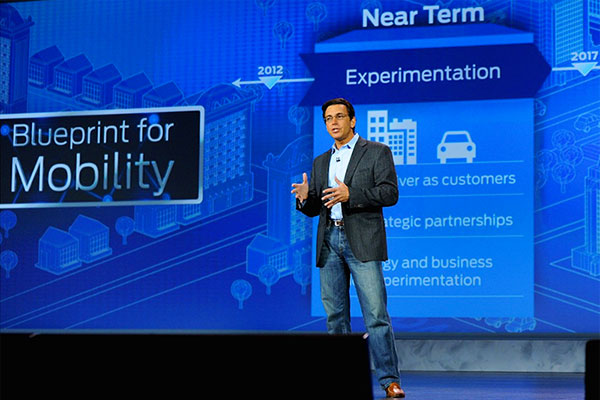Ford Motor on Thursday announced the opening of its Research and Innovation Center Palo Alto, a 25,000 square foot facility that will help it accelerate the company’s innovation in connectivity, mobility, autonomous vehicles, customer experience and big data.
This is the latest addition to the automaker’s global network of R&D centers, which include its hometown facility in Dearborn, Michigan, where Ford has continued to focus on advanced electronics, human-machine interface, materials science and analytics.
Next-generation powertrain research, driver-assist technologies and active safety systems are now handled through its facility in Aachen, Germany.
“At Ford, we view ourselves as both a mobility and an auto company, as we drive innovation in every part of our business,” said Ford Motor President and CEO Mark Fields, pictured above speaking at CES 2015.
“This new research center shows Ford’s commitment to be part of the Silicon Valley innovation ecosystem — anticipating customers’ wants and needs, especially on connectivity, mobility and autonomous vehicles,” Fields added. “We are working to make these new technologies accessible to everyone, not just luxury customers.”
The Big Valley
This isn’t Ford’s first incursion into Silicon Valley. Its first Silicon Valley office opened in 2012. The new center, which is located in the Stanford Research Park, has a staff of 21 engineers, app developers and scientists; Ford expects that number to grow to 125 by the end of the year. Its presence in Palo Alto puts it near tech giants Google, Apple and Yahoo.
Ford is not the only auto maker that has set up shop in Silicon Valley as a way to be closer to these tech players.
“If you look at the Valley as a whole, car makers have been there for a while,” said Mark C. Boyadjis, senior analyst and manager for infotainment and HMI (human-machine interface) at IHS Automotive.
“Daimler and BMW set up shop in the 1990s,” Boyadjis told TechNewsWorld, “and Honda came to the Valley in 2003, the same year Tesla was founded.”
Even through the years of the great recession, automakers located their respective R&D facilities in the region to be closer to those tech companies, noted Boyadjis.
“Ford was actually late to the game, only opening the office in 2012,” he pointed out. “Many other automakers had opened offices before that, but that isn’t to say that Ford wasn’t actually working with those companies.”
Convergence of Auto and Tech
Ford’s expanded presence in Silicon Valley is just the latest signaling of the increased convergence of the auto industry and the high-tech world. This has been increasingly evident in the presence of the major automakers at CES, which this year took place a week before the North American International Auto Show in Detroit. In many ways, CES has become the new first auto show of the year.
“There is no denying the impact that CES has had on the auto industry, and Ford has had a presence at CES for some time,” said Ken Washington, vice president for research and advanced engineering at Ford Motor.
Ford Smart Mobility, introduced at CES 2015, aims to accelerate innovation in connectivity, mobility, autonomous vehicles and the customer experience. The Palo Alto team will lead its R&D efforts in those areas.
“Our presence there enables us to work collaboratively on these projects with the best in the tech world,” Ford’s Washington told TechNewsWorld. “If you look around at the tech ecosystem in cars, many have had their genesis in Silicon Valley — and much of this is changing the way people interact with their vehicles.
“We’re approaching a point where this is happening at a rapid pace, as the cost for electronic devices is coming down,” he added. “This allows for greater analytics within the car that can tell us how the customers are using their cars.”
Cars Are the New Consumer Electronics
The Ford Research and Innovation Center will work with various universities and other research facilities on a variety of applications that could allow users to communicate with their homes from their cars, or even have cars that one day drive themselves.
The result could be that Ford — and other automakers — will continue to see an increased presence at events such as CES.
“When we think of the connected car or the autonomous car, we need to realize these vehicles are really consumer electronics,” said Boyadjis.
“There is now more horsepower in the process than under the hood,” he quipped.
“The powertrain engineers might debate me on but that, but the innovations we’ve seen with this convergence just show that automobile and high-tech are normalized,” Boyadjis maintained. “The automakers want to be in the Valley for the cooperation they can get with Apple and Cisco and other high-tech firms, and they’re not likely to leave any time soon.”






















































